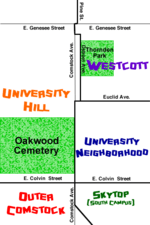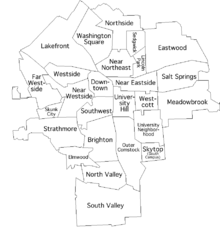University Neighborhood, Syracuse, New York
The University Neighborhood is one of Syracuse, New York's 26 officially recognized neighborhoods. It borders the neighborhoods of Westcott to the north, University Hill to the west, Outer Comstock to the southwest, Skytop (South Campus) to the south, and Meadowbrook to the east.

The University Neighborhood is mostly residential, with only a few convenience stores located throughout. The neighborhood is close to retail and dining, however, with Westcott Street being lined with small shops and restaurants immediately to the north, and the Nottingham Plaza across East Colvin Street at its southeastern corner. This plaza has a grocery store, Eckerd drug store, liquor store, barber shop, as well as a UPS Store behind it. Additionally, Marshall Street, the main retail area of adjacent University Hill is within a short walk of the northwestern corner of the neighborhood. The neighborhood is also home to the city's only cooperative grocery store, the Syracuse Real Food Co-op.
History
Like its surrounding neighborhoods, the University Neighborhood grew as a result of the growth of Syracuse University, which was founded in 1870. Electric streetcars ran along Euclid Avenue, its northern border. As the university continued to grow, particularly after World War II, students moved into many of the houses along Euclid Avenue and its side streets. When the university went through a short period of enrollment decline in the early 1990s, it enacted a sophomore residency requirement, which required second-year students to live in university housing. Previously only freshmen were required to do so. As a result, some University Neighborbood buildings were acquired by non-students . It also includes the Berkeley Park Historic District .
The Berkeley Park Subdivision Historic District, Spencer House, Ward House, and Welsh House are listed on the National Register of Historic Places.[1]
Conflicts
Today the neighborhood consists of a mixture of families and students. This unusual combination results in vibrant diversity, but is also sometimes a cause of conflict due to differing priorities of the two groups. Though conflict is usually limited to noise complaints from late-night student parties, an extreme example occurred on May 1, 1999 when students hosted a block party on Livingston Avenue. Violence broke out when police arrived to end the party, causing the event to be named the Livingstock Riots. Police used riot gear to break up the block party, which had spun out of control, leaving piles of furniture and debris burning in the streets. Subsequent block parties (resuming in 2007) have not featured violence.
References
- "Off-campus residents face tougher law enforcement". The Daily Orange. September 5, 2003. Archived from the original on May 20, 2004.
- "Neighborhoods of Syracuse". City of Syracuse. Archived from the original on February 12, 2005. Retrieved April 4, 2005.
- "Livingstock Riots". A.T. Marts. Retrieved April 4, 2005.
